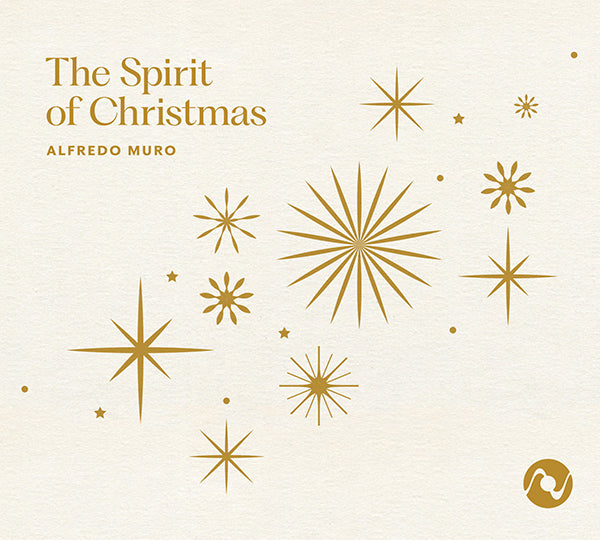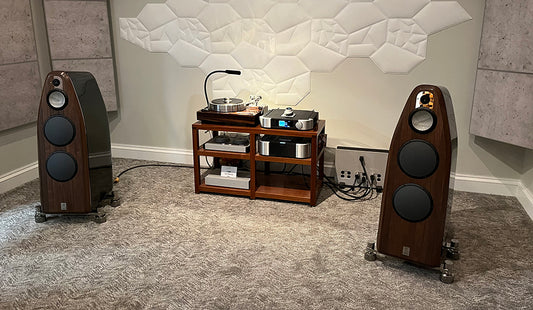Octave Records celebrates the holidays with The Spirit of Christmas by internationally-renowned guitarist Alfredo Muro, who brings a heartfelt intimacy and virtuoso performances to a wide range of seasonal favorites. The album is recorded in extraordinary sound, using Octave Records’ exclusive Pure DSD high-resolution audio process.
Alfredo Muro is a concert guitarist, composer, arranger, and improviser. He’s been described as a Latin guitar virtuoso, yet his styles and tastes are far more wide-ranging, from the classical repertoire to folk, jazz, Brazilian and more. He noted, “The idea of the program presented on The Spirit of Christmas was to choose traditional Christmas themes, combined with Christmas music popular in Spain and South America. Many of those songs are connected to my heart – they are part of my childhood in Latin America.”
The selections range from holiday standards like “Silent Night,” “The Christmas Song” and “White Christmas” to spiritual works such as “Jesus Bleibet Meine Freude” (“Jesu, Joy of Man’s Desiring”) and “Ave Maria, and songs that are deeply personal to Muro including “Preludio de Adiós” and “El Noi de la Mare.” Muro’s Paco Santiago Marin classical guitar has a deeply rich tone with a wide color palette and superb dynamic nuances, all captured in remarkable fidelity. On “Villancico de Navidad,” Alfredo is joined by guitarists Robert Chirico, Adam Buer and Felicity Muench and bassist Allen Bossard, to close The Spirit of Christmas on a beautiful and graceful note.
The album, available on disc or via download, was recorded, mixed and produced by Paul McGowan at Octave Records’ studio, with assistance from Jessica Carson, Alfredo Muro, and Terri McGowan. It was mastered by Gus Skinas. The Spirit of Christmas feature Octave’s premium gold disc formulation, and the disc is playable on any SACD, CD, DVD, or Blu-ray player. It also has a high-resolution DSD layer that is accessible by using any SACD player or a PS Audio SACD transport. In addition, the master DSD and PCM files are available for purchase and download, including DSD 256, DSD 128, DSD 64, and DSDDirect Mastered 352.8 kHz/24-bit, 176.2 kHz/24-bit, 88.2 kHz/24-bit, and 44.1 kHz/24-bit PCM. (SRP: $19 – $39, depending on format.)
I talked with Alfredo Muro about the making of The Spirit of Christmas and his approach to guitar playing and music.

Courtesy of Alfredo Muro.
Frank Doris: Your guitar has such a warm, rich tone. I see from your website that it’s a Paco Santiago Marin. Can you tell us something about the instrument
Alfredo Muro: Paco Santiago Marin's guitars are the perfect complement to what I demand from a concert guitar.
His guitars have already achieved well-deserved worldwide prestige for their high sound quality, great projection, infinite sustain and clear, clean and crystalline sound.
In his guitars the priority is the timbre richness, and its colors, which greatly favor the guitarist who likes dynamics, and at the same time that they are lyrical and have a powerful sound.
He is rightly considered among the best luthiers in the world.
FD: How did you choose the repertoire for The Spirit of Christmas? Are there songs that have a deep personal meaning for you?
AM: The idea of the program presented on The Spirit of Christmas was to choose traditional Christmas themes, combined with Christmas themes popular in Spain and South America. Many of those songs are connected to my heart; they are part of my childhood in Latin America.
FD: How do you approach learning and performing a new piece?
AM: It is a very good question. When one is faced with a new piece, whether classical, baroque, romantic or contemporary, I always like to explore the time and place of each piece to understand the historical circumstances and times of the composer. Many times, the title of a song can say everything, and if there is no story behind the piece, one must be created, in order to give a meaning to what one is trying to express with the instrument.
FD: Are there elements of improvisation or spontaneity in the performances on the album, or are you working from written arrangements?
AM: With the exception of a couple of songs, the other songs always carry my own free and spontaneous stamp. In general, I never play the same thing the same way, and the one who can attest to that is my wife, who knows my repertoire from A to Z. She always notices how much I make changes and improvise.
FD: I like the fact that your arrangements sound very personal, with your own twists on some of them. Some of the chords and chord melodies, for example, in “The Christmas Song,” are more like jazz than classical voicings. Can you comment on that?
AM: I think that the work of the arranger is like that of the decorator. The architect designs the base and the structure and as a "decorator," one tries to fill the structure of the theme with colors and chromaticism.
There is always in my playing a base in classical technique, but with jazz connotations. In other words, my technique is classical but my mind is jazzy.
FD: How did you get started on playing the guitar, and why did you choose guitar as an instrument?
AM: In many Latin American homes there is always a guitar hanging on the wall, since this Hispanic Moorish instrument is the national instrument in many countries.
I come from a very artistic and musical family and there was always a guitar that animated the gatherings at home.
I chose the guitar as my instrument because it is a very versatile and intimate instrument, which despite being a labyrinth of limitations has an incredible polyphonic capacity. Almost everything can be played on the guitar.
FD: You are not strictly a “classical” or “bossa nova” or “Latin” or any other type of guitarist. How did you come to be influenced by so many styles?
AM: Since I was a child, I have always been fascinated by the musical diversity that exists in the world, from a Paraguayan guarania, a waltz from my country Peru, the Argentine tango, the Venezuelan joropo, the bossa nova, samba and choro, the Chilean cueca, the Rio de la Plata milonga, the music of the Andes, Spanish music, jazz, even baroque music. I believe the influence comes from the fact that all kinds of music were listened to and sung at home.
FD: Who are some of your musical influences? They don’t necessarily have to be guitarists.
AM: My reference in music is Johann Sebastian Bach. In my personal opinion he is the most influential musician of all time. We are still learning from him. I also love Debussy and Villa-Lobos, and among guitarists, Agustin Barrios, Baden Powell, Julian Bream and John Williams.
FD: Who are some of the guitarists performing today who you like?
AM: There are many guitarists and talents today. I love the work of Ricardo Gallén, Alvaro Pierri and Roberto Aussel.
FD: How did you get involved with the people at Octave Records? And I have to ask everyone this – what was it like to hear your music recorded and played back with such good sound quality?
AM: I had the pleasure of meeting Jessica Carson some time ago and she offered me this possibility of recording with Octave Records. It was definitely a unique and nice sonic experience! Their sound equipment is super-sophisticated.
FD: You collaborate with two other guitarists and a bassist on the album’s finale, “Villancico de Navidad.” How did you come to know them and get them to play on this track?
AM: I have the pleasure of having very good friends and excellent musicians such as Rob Chirico, Felicity Muench and Adam Buer, and having Allen Bossard on double bass. They loved the idea of participating in the recording of “Villancico de Navidad.”
FD: I see you accept students. What advice would you give to a young person who wants to study guitar?
AM: Yes, I love teaching, it is another of my passions besides presenting concerts. I always tell my students that it is very important to have passion for what you do; work, discipline and resolution. In music, 20 percent is talent and 80 percent is work, or in other words: 20 percent is inspiration, 80 percent is perspiration!
Thank you for the opportunity and such a nice interview!




